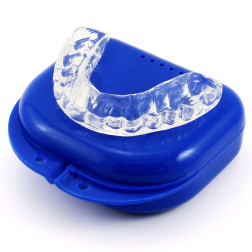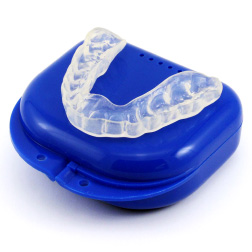Jaw Shifting to One Side
26th Oct 2025

Noticing your jaw shift to one side when you talk or chew can feel strange or even worrying. But in many cases, it’s not serious and can be managed with the right care.
A shifting jaw can happen for different reasons, like an uneven bite, muscle tension, or jaw joint issues such as TMJ disorder. Understanding what’s causing it is the first step to finding relief.
In this post, we’ll explain the common causes, symptoms to look out for, and what you can do to treat or manage the issue.
What Does It Mean If Your Jaw Shifts to One Side?

If your jaw moves more to one side when you open your mouth, chew, or speak, it may be a sign of imbalance in how your jaw functions. This is often caused by how your teeth fit together, how your jaw muscles work, or how your jaw joint moves.
Some people notice it as a change in their bite or appearance. In many cases, the shift is mild, but it’s still important to pay attention, especially if it’s new or getting worse.
Note: A shifting jaw doesn’t always mean something serious is wrong, but it can affect how you chew, speak, or rest your jaw. Catching it early can help you avoid further issues.
Is It Dangerous If Your Jaw Shifts to One Side?
A shifting jaw isn’t always something serious, but it’s still important to pay attention—especially if you’re feeling pain, tightness, or having trouble chewing.
In many cases, the problem is mild and can be managed with simple treatments. But if ignored, it could lead to more pressure on your teeth and jaw joints, cause your teeth to wear down faster, and even lead to frequent jaw pain or headaches. Over time, your bite could become more uneven and harder to correct.
Note: The good news is that most of these issues can be prevented. With early care, you can avoid long-term problems and feel more comfortable every day.
Common Causes of Jaw Shifting
A jaw that shifts to one side can happen for a few different reasons. Some causes are related to your bite, while others are linked to your jaw muscles or joints. Here are the most common ones:
Evolutionary Perspective
The article "The Root of Misaligned Jaws" explains that eating too many soft, processed foods reduces chewing, which can lead to weak jaw muscles, smaller jaws, and crowded teeth. Historically, people ate tougher foods that needed more chewing, which helped jaws grow stronger and wider.
Stress and Teeth Grinding (Bruxism)
Clenching or grinding your teeth, especially at night, puts pressure on your jaw. Over time, this can lead to muscle tension and jaw misalignment, particularly if it occurs more on one side.
TMJ Disorder (Temporomandibular Joint Dysfunction)
TMJ disorder affects the joint that connects your jaw to your skull. When this joint becomes inflamed or misaligned often caused by joint overuse, bite imbalance, or degenerative changes in the TMJ, it can cause your jaw to move unevenly.
Bite Misalignment (Malocclusion)
If your teeth don’t line up properly when you bite down, it can cause uneven pressure on your jaw. Over time, this may lead to your jaw shifting to one side. Common types of misalignment include underbite, overbite, or crossbite.
Chewing More on One Side
Some people have a habit of chewing mostly on one side of the mouth. This can make the muscles on that side stronger, causing the jaw to pull in that direction. You might not even realize you’re doing it.
Jaw Injury or Trauma
A past injury to the jaw or face, such as from a fall or accident—can cause long-term changes in jaw movement or alignment. Sometimes, the effects don’t show up right away.
Symptoms That May Accompany Jaw Shifting

If your jaw is shifting to one side, you might notice more than just the movement itself. Here are some common signs that can come with it:
- Clicking or popping sounds when you open or close your mouth
- Uneven bite or the feeling that your teeth don’t line up properly
- Jaw pain or tightness, usually on one side
- Difficulty chewing or discomfort when eating
- Facial asymmetry, where one side of your face looks or feels slightly different
- Headaches or pressure near your temples
Note: These symptoms don’t always mean something serious, but they’re signs your jaw might be under stress. Paying attention to them can help you take action early and avoid further problems.
Related Articles:
How Is Jaw Misalignment Treated?
The right treatment depends on what's causing your jaw to shift. In many cases, you won’t need anything invasive. Here are some common ways to manage and treat jaw misalignment:
Orthodontic or Dental Treatment
If your bite is uneven, your dentist or orthodontist might recommend braces or aligners. These help move your teeth into better alignment and reduce strain on your jaw. In some cases, bite adjustments or reshaping certain teeth can also help.
Physical Therapy and Jaw Exercises
Jaw exercises or physical therapy can help if tight muscles or joint stiffness are causing the problem. These stretches improve jaw movement and reduce tension, making it easier for your jaw to move naturally.
Stress Management Techniques
Stress often leads to jaw clenching or grinding, especially at night. Managing stress through relaxation techniques, better sleep habits, or mindfulness can ease the pressure on your jaw.
Night Guards for Bruxism Relief
A custom night guard can reduce pressure on your jaw while you sleep. If grinding or clenching is contributing to the shift, wearing a night guard helps protect your teeth and eases tension in your jaw muscles.
Related Articles:

- Most Popular
- Hard Outside, Soft Inside
- 2MM Thick
- Moderate / Heavy

- Most Durable
- Hard Materials
- 1.5MM Thick
- Heavy / Severe

- For Day Time Use
- Thin, Barely Visible
- 1MM Thick
- Light / Moderate

- For Clenching
- Flexible & Soft
- 1.5MM Thick
- Light / Moderate
When to See a Dentist or Specialist
It’s best to see a dentist if your jaw keeps shifting or the discomfort affects your daily life. Get help if the shifting gets worse, your bite feels off, or your jaw feels sore—especially when chewing or waking up.
Clicking sounds, uneven pressure, or nighttime grinding are also signs it’s time for a checkup. A dentist or TMJ specialist can find the cause and recommend the right treatment. Early care makes it easier to manage and prevent bigger issues.
FAQs About Jaw Shifting
1. How long does it take to fix a shifting jaw?
It depends on what’s causing the shift. Sometimes it improves in a few weeks with rest or simple dental care, but it can take months if it’s related to bite problems, joint issues, or injury. A dentist or specialist can check the cause and recommend the right treatment plan.
2. Can It go away on Its own?
In some cases, a shifting jaw can improve on its own—especially if it’s due to stress, muscle tension, or mild grinding. Managing stress, avoiding clenching, or using a night guard may help ease the symptoms over time.
3. Will a night guard stop my jaw from shifting?
A night guard won’t shift your jaw back into place, but it can reduce pressure, protect your teeth, and help stop the problem from getting worse, especially if grinding is involved.
Final Thoughts: Don’t Ignore Jaw Shifting
If your jaw is shifting to one side, it could mean something’s off—like your bite, jaw muscles, or habits such as clenching or grinding. Catching it early can help prevent discomfort and long-term problems.
Many cases can be managed with simple, non-invasive solutions like a custom night guard, stress relief, or dental advice.
If you’re grinding your teeth or noticing changes in your bite, a custom night guard from Pro Teeth Guard is a smart and affordable first step. It helps protect your teeth and support better jaw alignment—right from home.
References:
- Miller, J. (2018). The root of misaligned jaws. Scientific American, 319(5), 46–51. https://www.jstor.org/stable/26586154
- Bashir, A., Jawa, D., Somani, R., Jaidka, S., Magray, I., Ahmad, L., Hridya, V. G., & Madhu, A. (2021). All about bruxism—The teeth grinding. Journal of Advanced Medical and Dental Sciences Research, 9(5), 9–23. https://jamdsr.com/uploadfiles/3vol9issue5pp9-23.20210507111208.pdf
- Chen, Y.-W., Liu, J.-F., Lin, C.-P., & Lin, H.-Y. (2017). Association between sleep bruxism and temporomandibular disorders: A systematic review and meta-analysis. Journal of Dental Sciences, 12(4), 299–306. https://doi.org/10.1016/j.jds.2017.06.003

- Most Popular
- Hard Outside, Soft Inside
- 2MM Thick
- Moderate / Heavy

- Most Durable
- Hard Materials
- 1.5MM Thick
- Heavy / Severe

- For Day Time Use
- Thin, Barely Visible
- 1MM Thick
- Light / Moderate

- For Clenching
- Flexible & Soft
- 1.5MM Thick
- Light / Moderate
